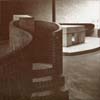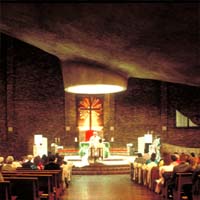
This was Cardinal's first significant architectural commission that
launched his career. The building was commissioned for design in 1964,
and was completed in 1968 at a total cost of $300,000. The building
occupies 13,150 square feet in Red Deer, Alberta.
Cardinal had to defy conventional construction processes to create
this unique building. Interior and exterior walls of brick were
built first, then progressively filled with lightweight aggregate
concrete in order to eliminate the need for large arrays of
concrete formers and scaffolding. The ceiling was designed to be
tent-like, with an off-centre apex and a natural fall, produced by
using cloth. The projected cost for the steel was $120,000, or
$90,000 for wood. Actual costs were a mere $60,000 because Cardinal
used concrete.
Given the weight of concrete, the finished ceiling weighed over 250
tons. In order to obtain approval to construct something of immense
proportions, Cardinal had to provide hard data and calculations in
order to prove that it was feasible and structurally sound. At that
time, no computer in Canada could process 81,000 equations he
required to validate his ideas and theories, thus he headed south
of the border and rented computer time in Chicago.
Once he had his data, Cardinal mounted a huge concrete tube-like
structure at the planned apex of the ceiling, and strung high-tensile
steel cables from the apex to anchors in the walls, much
like a spider's web. He then suspended steel mesh 1.5 inches below
the cables and poured in 3 inches of concrete from above, embedding
the cables. Once the concrete was set, the cables were
post-tensioned to pull the apex up to its planned height. Today, it
forms a hanging skylight that directs a shaft of light onto the
altar area.
|




























